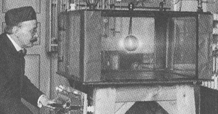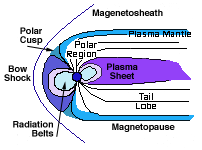|
[an error occurred while processing this directive]
16. The Magnetosphere |
|
What are those "magnetic storms" which occasionally disturb the Earth's magnetic field? Unlike changes of the internal field, they happen quickly, over hours or days--and magnetic variations from the polar aurora ("northern lights") are even faster. Whatever causes them is outside the Earth, not in the core. But what?
|
[an error occurred while processing this directive]
|
Earth's Core Tobacco Smoking & Moving Continents |
Birkeland's TerrellaMagnetic storms and the sunspot cycle seem subtly connected. Large storms appear more frequently (though not only) during years of high sunspot activity, and such storms also cause auroras at unusual locations, much further from the magnetic poles--even in the middle of Europe and of the United States.
|
|
Was this a clue why the polar aurora is usually seen only within a limited distance of the magnetic poles?
It indeed was. The French mathematician Henri Poincaré--and 50 years later, in more detail, Hannes Alfvén in Sweden--analyzed the motion of such electrons and concluded that they were guided by magnetic field lines, like beads strung on a wire. From his terrella experiment, Birkeland guessed that the aurora was caused by electrons from the Sun, which were guided by magnetic field lines to the Earth"s polar caps, and produced there a glow as they hit in the upper atmosphere. As it turned out, the Sun was not the source, but the rest of the guess was pretty close to the truth.
Alfvén's theory suggested how this current could be carried. Charged particles, such as ions or electrons, were not only guided by magnetic field lines, but as they slid along such lines (more accurately, spiralled around them), they were also repelled (in a way) from regions of more intense magnetic field.
One can show that by secondary processes, such particles also slowly change their attachment from one field line to its next neighbor, gradually circling the globe--clockwise (view from far north) for positive ions, counterclockwise for negative electrons. However, any time negative electrons move one way and positive ions the opposite way, an electric current is created! That was indeed how S.F. Singer in 1957 proposed to explain the existence of a ring current during magnetic storms.
It is this tail where many active phenomena of the magnetosphere--part of our "space weather"--originate. Of special interest is a thick layer known as the plasma sheet, spread in the region of weak magnetic field which is sandwiched between two bundles of magnetic field lines. One bundle, north of the equator, consists of field lines that head into the vicinity of the north magnetic pole, and the other bundle is its mirror image south of the equator, of field lines directed out of the southern polar cap. The plasma sheet is where ring current particles originate, and where "substorms" shove particles earthward and create bright auroral displays.
The Polar AuroraIn locations such as Fairbanks, Alaska or Tromsö, Norway, the polar aurora is not at all rare. Its bright visible arcs appear to be associated with strong electric currents linking Earth to space. Unlike the ring current, such currents are driven by voltage difference (like currents in the home or in a flashlight).In space such currents most easily flow along magnetic field lines, because the particles that carry them (mainly electrons) tend to stay attached to such lines. Some flow from space to Earth, some from Earth to space, and near Earth their circuit is completed by a layer in the high atmosphere that conducts electricity well, the E-layer of the Earth"s ionosphere, located some 125 km above ground. The currents do not reach the ground, because air at lower levels is a very good electric insulator.
The polar aurora is created by electrons moving earthward while carrying this current. They gain speed from the driving voltage and after reaching the atmosphere, smash into atoms of oxygen or nitrogen, causing them to emit light. The typical aurora has an eerie greenish glow, emitted by oxygen.
Next Stop: 17. Planetary Magnetism Back to the Master List |
Mail to Dr.Stern: earthmag("at" symbol)phy6.org
Last updated 25 November 2001
Re-formatted 19 March 2006




